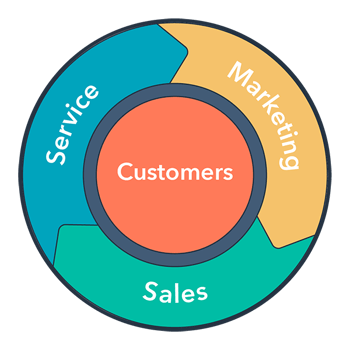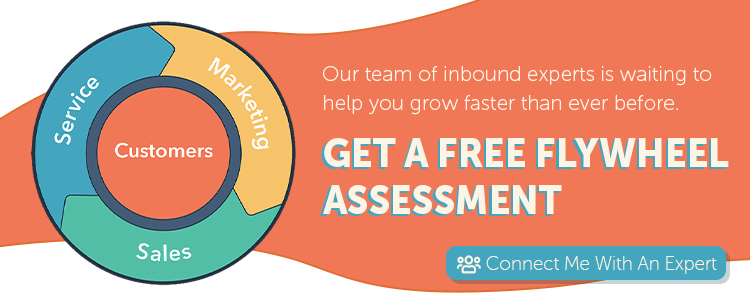The funnel is dead, and the inbound methodology has completely shifted to the flywheel framework.
HubSpot recently announced a big shift in the way we think about inbound strategy at Inbound 2018. This obviously ruffled some feathers in the marketing world. We are all accustomed to thinking with a funnel mindset.
But the flywheel buried the funnel. And it did so because it's inherently better in many ways.
It's Self-Perpetuating.
A funnel is top heavy. This requires businesses to invest all their energy and force into attracting and acquiring customers. But this is short-sighted. It's too linear.
The flywheel, on the other hand, fuels itself and is designed to leverage momentum. In terms of operating your business, you're not just bringing in customers and completing your contract.
You're fully investing in setting them up for continuous growth. The flywheel brings you into the customer-centric world.
It Requires Alignment.
With the funnel, many organizations understood the value of aligning all of their teams, but they treated it like a nice-to-have. But with the flywheel, your success and momentum depend on full alignment.

Silos be damned. In a flywheel world, your marketing, sales, and service teams must be constantly talking, ensuring that you deliver a top notch experience at every customer touchpoint.
It's Relationship-Focused.
This is arguably the most important distinction between the funnel and flywheel. Your focus isn't just on closing deals; your focus is on building and maintaining positive relationships.
The relationship focus is what spins your wheel and keeps it spinning. Theclient-business relationship has always been interdependent, and the flywheel shows as your customers grow, your wheel spins faster, fueling your growth.
You can accelerate customer growth and your growth in any of thethree flywheel stages:
Attract
You're earning attention and attracting visitors by delivering high-value content and simplifying your audience's ability to learn more about your organization.
Engage
As you interact with prospects, you're building relationships, enabling them to engage with you how they want and when they want.
Delight
Continually delivering a positive customer experience accomplishes two important things: you further establish yourself as a credible, reliable resource, and you turn your customers into advocates for you.
So why this sudden change? Why did HubSpot decide to put the funnel to rest?
As they did in 2006, when HubSpot was founded and introduced the world to inbound, they're staying ahead of the curve and introducing changes that evolve with the world of business.
Skating to Where the Puck Is Going
I skate to where the puck is going to be, not where it has been.
- Wayne Gretsky
We've all seen this quote because it carries a lot of weight, especially in the context of business — you should always aim for where the market is headed, not where it is now.
HubSpot lives by this sentiment. When they first started over 10 years ago, they introduced the inbound methodology to better serve the digital world. They noticed that customers were starting to take more control in the buying process.
Thanks to the internet, consumers were equipped with information and tools they need to research products and services to make informed buying decisions. Plus, they were getting better at avoiding and ignoring interruptive, outbound marketing tactics.
Now, they see the shift toward what they call the "hard truth" about marketing. They see that the push for content marketing increased the sheer amount of content in the world, so naturally consumers got better at filtering out content, just as they learned to filter out disruptive advertising and outbound tactics in 2006.
In 2018 and onward, people put a lot more value on recommendations from their friends and families than on what you say about your organization. HubSpot's research found that people are:
- Less patient – 90% of consumers expect an immediate response from representatives.
- More skeptical – Just 3% of people say marketers and salespeople are trustworthy.
Hence, the reliance on word of mouth continues to gain steam. In fact, as HubSpot's research found, word-of-mouth referrals and customer references are the top sources of information people rely on when making purchase decisions for business software.
As you can see, the flywheel framework isn't just some trendy update on business jargon. It's a necessity.
But an important question comes to mind.
Are We Ready?
The unfortunate truth is that we are not even close.
While HubSpot is yet again ahead of the curve, most of the market is taking forever to catch up. Many companies are just now getting started with inbound marketing.
You can see the slow adoption of inbound marketing, from the early days up to now. For instance, HubSpot's 2009 State of Inbound Marketing report found that just 37% of business’ lead-generation budget was dedicated to inbound marketing, whereas 30% was dedicated to outbound marketing efforts.
Inbound delivered leads that cost way less, as compared to outbound. The same report found that those who spent 50% or more of their lead generation budget on inbound marketing averaged $84 per lead, and businesses spending 50% or more on outbound marketing averaged $220 per lead.
Fast forward to now, and inbound is still not fully embraced. HubSpot's 2018 State of Inbound report found that 74% of global organizations primarily use inbound marketing. This is impressive, but what about the remaining 26% of companies not using inbound?
And those who are using an inbound marketing strategy are still taking too long to adopt an inbound sales approach.
That's right, in a world where sales and marketing alignment is a must, most organizations are still working in silos. The same 2018 HubSpot report found that just 26% of respondents use a formal service level agreement (SLA) for their sales and marketing teams. Of those using an SLA, 85% say their marketing strategy is effective.
Bottom line: adoption was slow with inbound marketing. It's currently slow with smarketing. And this pattern will continue with the flywheel.
Most of the market will take years to catch on. By the time they do, their competitors who are using the flywheel framework will already have left them in the dust.
The Blue Ocean Awaits
Early adopters for every shift in business strategy enjoy the blue ocean, a term coined by W. Chan Kim and Renée Mauborgne in their book, The Blue Ocean Shift. A blue ocean is an unknown market space offering plenty of opportunity for growth. Competition doesn't exist yet, and the rules are waiting to be set.
Thanks to HubSpot's flywheel framework, a new blue ocean awaits. Opportunities are endless now because most of the market is still several steps behind.
Now is the time to turn the ship.


Eric Baum
Eric is the CEO / Founder of Bluleadz. His passion is growing businesses and listening to Jimmy Buffet. Oh yeah, and golf when he can find the time.